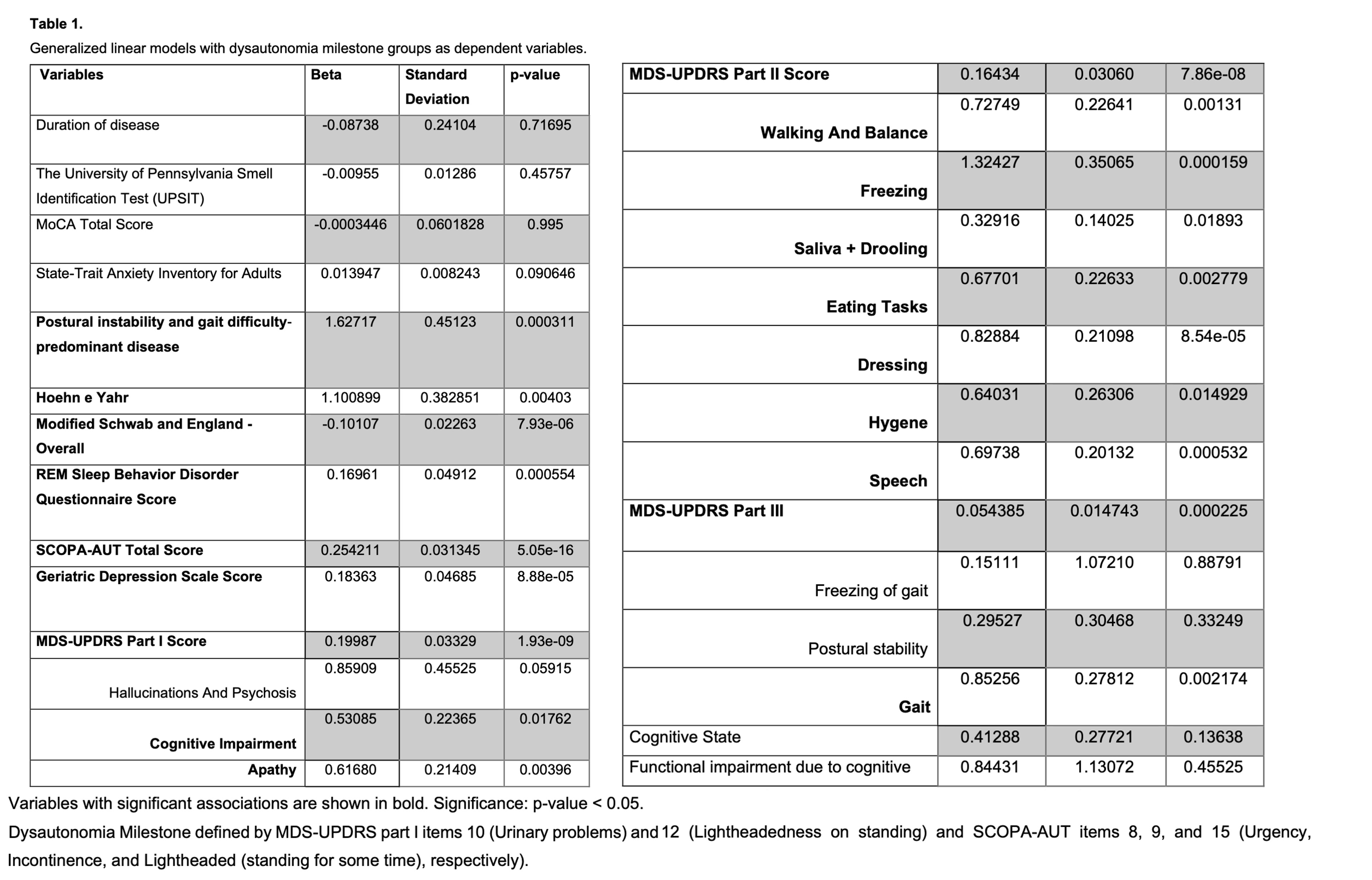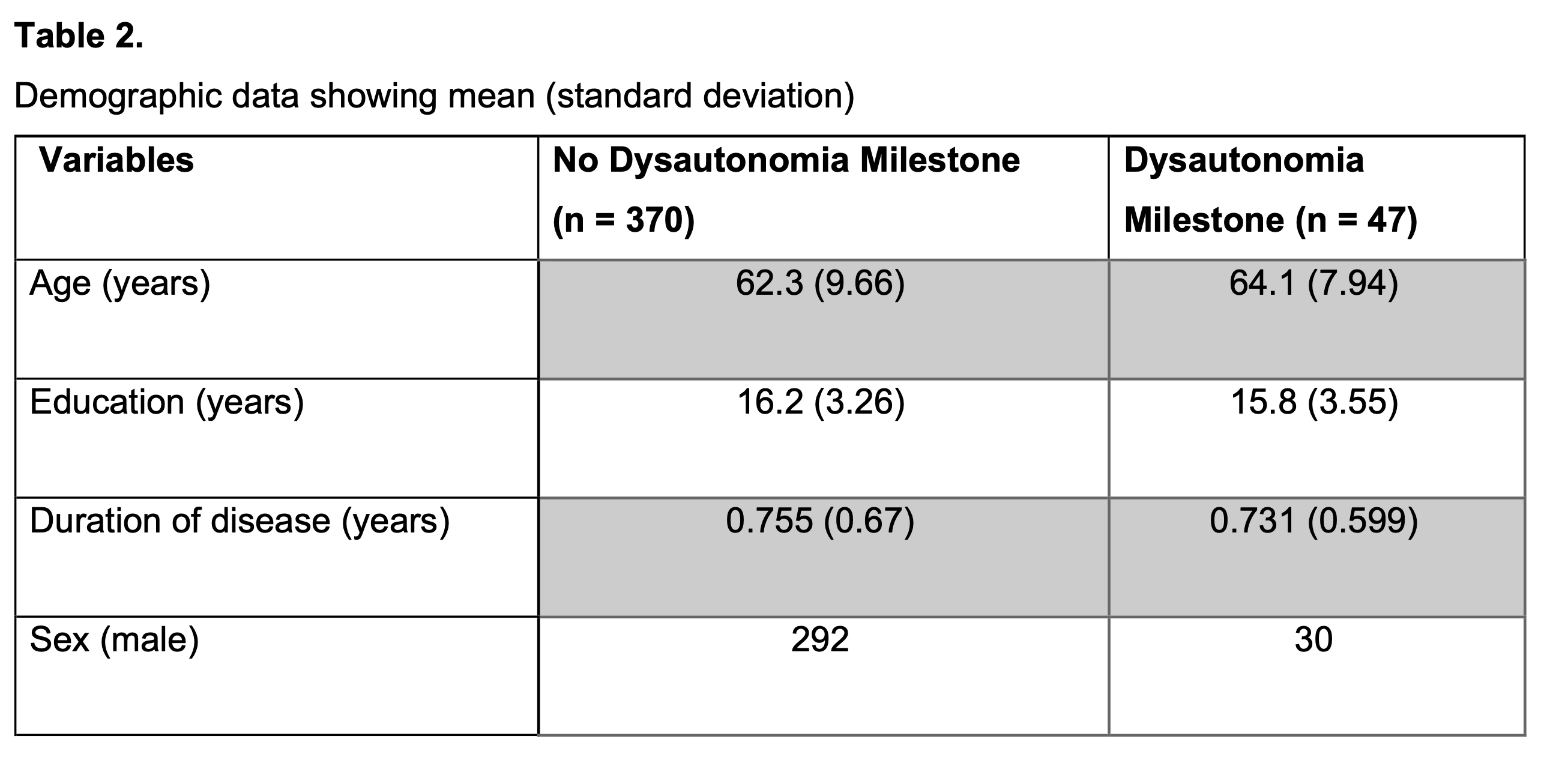Category: Parkinson's Disease: Non-Motor Symptoms
Objective: To evaluate whether clinical and neuroimaging baseline markers predict the onset of significant dysautonomia over five years in individuals with idiopathic, de novo Parkinson’s disease (PD) within a large cohort.
Background: Dysautonomia symptoms (DS) in PD significantly impact the quality of life and lead to poorer outcomes. Given the heterogeneity in PD, individuals develop DS in varying degrees. Identifying predictive markers can facilitate the application of tailored treatments and preventative strategies.
Method: We analyzed the Parkinson’s Progression Markers Initiative (PPMI) [1] to compare individuals with PD who developed a dysautonomia milestone over five years (DM, n = 47) with those who did not (no-DM, n = 370). All individuals had early-stage PD and were not on PD medications at baseline. We defined DM based on MDS-UPDRS Part I items 10 and 12 and SCOPA-AUT items 8, 9, and 15 [2]. We compared baseline clinical data between groups and expanded on the previous studies by analyzing magnetic resonance imaging volumetric brain data (MRI). MRI volumetric analysis of regions of interest was performed using Freesurfer’s v7.4.1 recon-all pipeline. Comparisons were conducted using generalized linear models adjusted for age and gender. Analysis was conducted in Python version 3.6 and R environment, using a 95% confidence level.
Results: Our results showed that patients who reached the DM over five years already presented in the baseline significantly lower volumes of the left (p = 0.033) and right thalamus (p = 0.031) compared to no-DM. DM was associated with postural instability and gait difficulty predominant disease (p < 0.001), lower values in the Modified Schwab and England (p < 0.001), and higher values in the REM Sleep Behavior Disorder Questionnaire Score (p < 0.001), SCOPA-AUT (p < 0.001), the Geriatric Depression Scale Score (p < 0.001), MDS-UPDRS Part I Total Score (p < 0.001), MDS-UPDRS Part II Total Score (p < 0.001), MDS-UPDRS Part III Total Score (p < 0.001), besides other variables shown in [table1].
Conclusion: These findings indicate that in early-stage PD, various clinical features and brain volumetric measures are already differentially associated with the later emergence of severe DS. Ultimately, these results support the presence of early underlying determiners of PD trajectories that may have been established during a pre-clinical stage of PD.
Table 1
Table 2
References: [1] www.ppmi-info.org/access-data-specimens/download-data
[2] Brumm MC, Siderowf A, Simuni T, et al. Parkinson’s Progression Markers Initiative: A Milestone-Based Strategy to Monitor Parkinson’s Disease Progression. J Parkinsons Dis. 2023;13(6):899-916. doi:10.3233/JPD-223433
To cite this abstract in AMA style:
A. Oliveira Franco, M. Machado Schlindwein, J. Rossi Catao, D. Teixeira-Dos-Santos, A. Bieger, T. Hugentobler Schlickmann, L. Angi Souza, C. Mattjie, F. Suzuki, G. Magalhães Pereira, L. Silveira Kupssinskü, L. Vinícius Moura, R. Ravazio, S. Duarte Pinto, M. de Bastiani, R. Barros, E. Zimmer, A. Schumacher Schuh. Clinical and Neuroimaging Biomarker Predictors of Autonomic Dysfunction in Parkinson’s Disease: A Study Using PPMI Data [abstract]. Mov Disord. 2024; 39 (suppl 1). https://www.mdsabstracts.org/abstract/clinical-and-neuroimaging-biomarker-predictors-of-autonomic-dysfunction-in-parkinsons-disease-a-study-using-ppmi-data/. Accessed October 18, 2025.« Back to 2024 International Congress
MDS Abstracts - https://www.mdsabstracts.org/abstract/clinical-and-neuroimaging-biomarker-predictors-of-autonomic-dysfunction-in-parkinsons-disease-a-study-using-ppmi-data/


